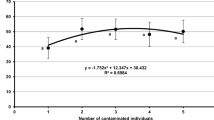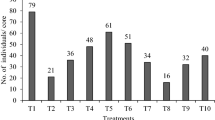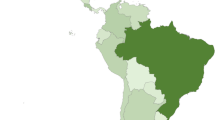Abstract
Environmental manipulation or conservation is one among several approaches evolved for harnessing the potentiality of entomopathogens in an integrated pest management. Cultural manipulation can permit the pathogen to reproduce more than usual or can preserve or enhance those already present. Among the key pest of chilli thrips, Scirtothrips dorsalis Hood (Thripidae: Thysanoptera) and broad mite, Polyphagotarsonemus latus [Banks] (Tarsonemoidea: Acari) are reported to cause the leaf curl in the leaves of chilli. Fusarium semitectum has infected the thrips and mites. The effectiveness of the mycopathogen, F. semitectum is chiefly influenced by the environmental conditions. Enhancing the microclimate the mycopathogen can be able to develop and buildup further. Chilli has been grown as sole crop, however companion crops such as sorghum, cotton, red gram, castor and maize were grown to understand the cropping system effect. Chilli-sorghum, chilli-cotton-chilli and chilli-red gram were the best cropping systems in terms of total chilli yield. The chilli-cotton-chilli cropping system ranked second with respect to benefit-cost ratio of 1:1 where as chilli-sorghum cropping system claimed the highest as 1.125:1. Interestingly, sorghum is not grown as a companion crop with chilli in Karnataka under rain fed conditions, where as chilli-cotton combination is a practice in many places of the state.
Similar content being viewed by others
References
Aiyadurai SG (1966) A review on research on spices and cashew nuts in India. ICAR, New Delhi
Ananthakrishnan TN (1969) Indian Thysanoptera, CSIR Zoological Monograph No 1. Publications and Information Directorate, CSIR, New Delhi, 171 pp
Ayyar TVR (1932) Bionomics of some thrips injurious to cultivated plants in South India. Agric Livestock India 2:391–403
Ayyar TVR, Subbaya MS, Krishnamoorthy PS (1935) The leaf curl disease of chillies due to thrips. Madras Agric J 23:408–411
Borah DC (1987) Bioecology of Polyphagotarsonemus latus (Banks) (Acari: Tarsonemidae) and Scirtothrips dorsalis Hood (Thysanoptera: Thripidae) infesting chilli and their natural enemies, Ph.D thesis, University of Agricultural Science, Dharwad, pp 165–202
Butani DK (1976) Pest and disease of chillies and their control. Pesticides 10:38–41
Fuxa JR, Tanada Y (1987) Epizootiology of insect diseases. John Wiley, New York
Hegde R (2001) Exploitation of Nomuraea rileyi (Farlow) Samson against important lepidopterous pests of potato, cotton and chickpea, Ph. D Thesis, University of Agricultural Sciences, Dharwad
Hosmani S (1993) Chilli crop (Capsicum annuum L.). M/S Bharat Photo offset work, Dharwad, 232 pp
Jeppson LR, Keifer HH, Baker EW (1975) Mites injurious to economic plants. University of California Press, Berkeley, pp 285–305
Kranz GW (1978) A manual of Acarology, 2nd edn. Oregon State University, Cornavalis, p 509
Kulkarni GS (1922) The “Murda” disease of chilli (Capsicum). Agric J India 22(1):51–54
Peiris JWL (1953) Chili leaf curl complex. Trop Agric 109:1–2
Puttarudriah M (1959) Short review on the chilli leaf curl complex and spray programme for its control. Mysore Agric J 34:93–95
Reddy DNR, Puttaswamy (1983) Pests infesting chilli (Capsicum annuum L.) in the transplanted crop. Mysore J Agric Sci 17:246–251
Acknowledgements
The authors wish to acknowledge the Director of Instruction (Research), University of Agricultural Sciences, Bangalore, Deputy Director (Research), Shimoga and the Director and staff members of ICCR for their help in conducting research in the research fields.
Author information
Authors and Affiliations
Corresponding author
Rights and permissions
About this article
Cite this article
Mikunthan, G., Manjunatha, M. Impact of habitat manipulation on mycopathogen, Fusarium semitectum to control Scirtothrips dorsalis and Polyphagotarsonemus latus of chilli. BioControl 53, 403–412 (2008). https://doi.org/10.1007/s10526-007-9086-0
Received:
Accepted:
Published:
Issue Date:
DOI: https://doi.org/10.1007/s10526-007-9086-0




